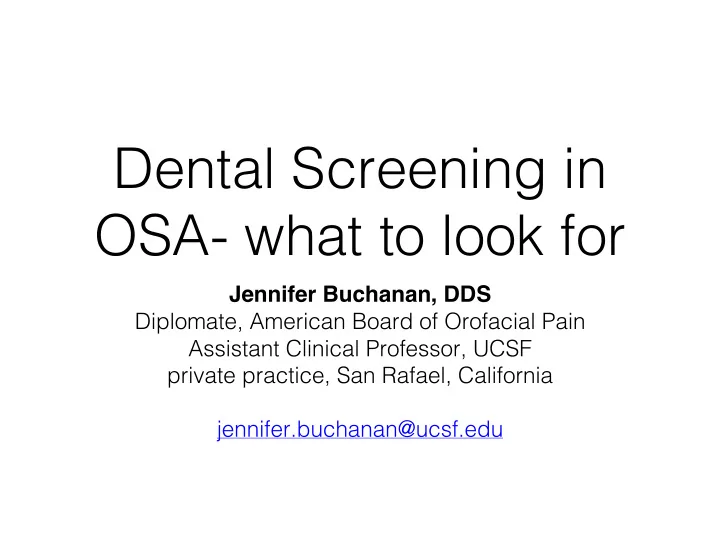

Dental Screening in OSA- what to look for Jennifer Buchanan, DDS Diplomate, American Board of Orofacial Pain Assistant Clinical Professor, UCSF private practice, San Rafael, California jennifer.buchanan@ucsf.edu
potential conflict of interest: none I am a consultant for Sleep Science Partners
Orofacial Pain Specialist: • Orthopedic issues: Temporomandibular Disorders • Headache • Neuropathic pain • Dental Diagnosis
put her photo here
Mandibular Advancement Devices “Herbst” “EMA”
put her photo here
My Dad
FTP I FTP IIA FTPIIB FTP III FTP IV Friedman, M, et al., Laryngoscope. (1999) 109;1901-1907 Friedman,M, et al., Otolaryngol Head Neck Surg (2013)148;540-547
grading of tonsils
Just another day at the Orifice! soft tissues: tongue size tonsil size oropharyngeal width Schwab, RJ, et al., Chest (2017);152;330-342
tongue scalloping “crenations”, “ridging” Weiss, Atanasov, Calhoun, Otolaryngol Head Neck Surg (2005);133;966-971
Hard tissues: craniofacial skeletal structures Risk factors independent of BMI: maxillary insufficiency posterior and inferior hyoid bone Associated with: retrognathia long and narrow face Dempsey, JA, Skatrud, JB, Jacques, AJ, et al., CHEST 2002 122(3):840-851 Riha, RL, et al., SLEEP 2005; 28(3): 315-320 Finkelstein, Y, et al., Laryngoscope. 2001; 111:634-641 Paoli, JR, et al., Br J Oral Maxilfac Surg. 2001 Feb;39(1):40-5. Guillemenault, CR, et al., CHEST 1984 86(5):793–794
retrognathic; overbite (horizontal overlap) Tsai,WH, et al., AJRCCM (2003); 167;1427-1432 Paoli, JR, et al., Br J Oral Maxilfac Surg. 2001 Feb;39(1):40-5. Guillemenault, CR, et al., CHEST 1984 86(5):793–794
photograph courtesy of Dennis Bailey, DDS deep bite (vertical overlap) Tsai,WH, et al., AJRCCM (2003); 167;1427-1432
high narrow palate posterior crossbite Dempsey, JA, et al ., Chest (2002);122;840-851 Poirrier, AL, Laryngoscope 2012 Oct;122(10):2350-4
photograph courtesy of Dennis Bailey, DDS Anterior open bite Posterior Crossbite (maxillary insufficiency) Dempsey,JA, et al., Chest (2002);122;840-851
prognathic: maxillary insufficiency Dempsey,JA, et al., Chest (2002);122;840-851
panograph courtesy of David Hatcher, DDS Periodontal Disease correlates with SDB: Sanders, Essick, Beck, et al., SLEEP (2015); 38;1195-1203 Famili, P. J Dent Oral Health (2015); 1;1-4 Gunaratnam, Taylor, Curtis, Cistulli, Sleep Breath (2009); 13(3):233-239 Carotid Artery Calcifications and OSA Friedlander, et al., J Oral Max Surg (1998) 56;950-954
“So, How’s your sleep?” • How%long%do%you%sleep?% • When%do%you%go%to%bed,%when%do%you%wake%up? • Do%you%have%trouble%falling%asleep/staying% asleep? • Do%you%feel%rested%and%refreshed%when%you% wake? • Do%you%feel%tired%during%the%day? • Do%you%snore?
TMD and SDB: arthritic changes in the TMJ create the anatomic correlates that are risk factors for SDB
Temporomandibular Disorders
TMD and Sleep Disorders: Increase in OSA and insomnia in patients with myofascial pain Smith, MT, et al., SLEEP, 2009; 32(6): 779-790 a significant but mild increase in stage N1 sleep • mild but significant elevations in RERAs and arousals • associated with all types of respiratory events TMD patients with pain on the night of PSG had lower sleep • efficiency, more frequent awakenings and higher RERAs Dubrovsky, B, Raphael, K, LeVigne, G, et al., JCSM, 2014; 10(2):195-201
Adenoidal faces, mouth breathing Schlenke ker, WL e al., J J Or Orth thod De Dent Or Orth thop 2000 Ju Jun;117(6):706-13 13 Lind Li nder er-Aronso son, S, Ac Acta Otolaryn yngol Su Suppl ppl.1 .1970;2 ;265:1 :1-132 132
Dentists are uniquely qualified to evaluate craniofacial development and structures age 8 years age 12 years
Intervention requires a team: Pediatrician Otolaryngologist Allergist Orthodontist
Sc Screening g the Pa Patient for Oral Appl Or Appliance Therapy py why do they why do they work? fail? • uncomfortable to wear • restorative sleep (jaw feels worse) • jaw feels better • bite changes • no more snoring • it didn’t work
what does an oral appliance do? 1. opens the vertical dimension of occlusion 2. advances the mandible
Good Candidates: anatomic factors The effects of an oral appliance on the airway
dilation of the upper pharyngeal airway reducing airway collapse
History includes: • Sleep history • medical history • jaw pain, jaw noises • neck pain, headache
Can you stand to wear an appliance? • gagging • tooth sensitivity • muscle pain • joint pain
Generally (but not universally) More Success With: • Younger • Lower BMI, smaller neck circumference • Mild-moderate OSA • Supine predominant • Retrognathic, lower hyoid position • Decent nasal airway Sutherland, K, et al., JCSM (2014);10;215-227 Zeng, B, et al. , SLEEP (2008);31;543-547
Exam • Muscle tenderness • Mandibular range and quality of motion • Joint findings: DJD? Disc disorder? • soft tissues, tongue size, pharyngeal space • response to mandibular repositioning (George Gauge)
subjective testing of the airway: The George Gauge • subjective sense of airway improved • snore sound diminished or eliminated • lip seal preserved • minimal mandibular advancement
The TMJ: Not necessarily a contraindication for OAT
the TMD patient and OAT • need a good range of motion • joint noises- crepitus? click? • test joint loading for capsule inflammation • radiographs • start with vertical change, slowly advance to efficacy
evaluate dentition • number of teeth • periodontal disease • tooth decay • existing restorations • occlusion
The Edentulous Patient: maintain or increase vertical dimension • wear their denture at night • fabricate an appliance to go over their denture • fabricate an appliance for night time wear- open the vertical, slightly advance the mandible, anterior space for the tongue
photograph courtesy of Dennis Bailey, DDS Edentulism and Worsening of Obstructive Sleep Apnea , The Lancet 1999; 353:121 Association of Denture Use with Sleep-Breathing among older adults , J Public Health Dent 2004; 64(3):181-183
Preventing bite changes: allow mandibular mobility with OA design • address bite changes right away • bite changes should last no more than a few • hours in the morning jaw massage, “tongue-up” stretching • exercises at delivery fabricate a soft ‘repositioner’ to bite • on
Nasal Airway Resistance For best results, evaluate and treat the patient for: • alar rim collapse • allergies, rhinitis • large turbinates • deviated septum • mouth breathing • etc. Zeng, B, et al. , SLEEP (2008);31;543-547
anatomic factors are not the whole story: Upper Airway Collapsibility and Loop Gain: Edwards, Andara, Landry, et al., AJRCCM (2016) 194;1413-1422
with thanks to Dennis Bailey, DDS and David Hatcher, DDS
Recommend
More recommend